GILROY
– A crane hoisted two large gifts from Gilroy’s past onto the
property of the Gilroy Museum Tuesday morning.
GILROY – A crane hoisted two large gifts from Gilroy’s past onto the property of the Gilroy Museum Tuesday morning.
Weighing in at more than 300 pounds and measuring about 33 inches in diameter and 7 inches top to bottom, the two millstones were a donation to the city from Gilroyan Edward Maier.
Connie Rogers, with the Gilroy Historical Society, thinks the stones date back to the mid-1800s and were used in a grist mill owned by one of Gilroy’s early pioneers.
“I think they are very significant because they probably belong to one of the first settlers here, Julius Martin,” Rogers said. “It is significant because the millstones relate directly to the way he made his living.”
Martin built the mill in the early 1850s and used it to grind wheat into flour which was used for making bread and other baked goods, according to museum documents. A horse harnessed to the mill supplied it with the power necessary to operate the heavy stones. Through this method, Martin processed about 20 bushels, a dry measure equal to 32 quarts, of wheat a day.
Maier’s father-in-law George White found one of the stones underneath the corner of an old building, actually supporting part of the structure, located off of Frazier Lake Road, Maier said. Maier said he discovered the second millstone under what he referred to as “junk” on property off of Holsclaw Road.
Maier estimates the value of the millstones at $1,500 to $2,000 each. Maier could’ve sold the millstones, but he chose to donate them to the museum.
“We had them in our will to go to the museum,” Maier said, “but decided to give them now since we’re moving.”
The stones will serve as an important part of the museum, Rogers said, reminding visitors of the old pioneer ways.
Pioneers Julius Martin, his wife, Elizabeth Hedrick McPherson, and their three daughters came over Walker Pass in 1843 led by American trailblazer Joseph R. Walker. Walker Pass crossed the southern Sierra Nevada east of Bakersfield.
They arrived in Old Gilroy – or as it was called then, “San Ysidro” – in December of 1843, making the Martins the first American family to settle in Gilroy. Julius Martin also was a captain of the American Scouts under direction of Gen. John Fremont. Martin was present when rebels raised the Bear Flag at Sonoma on June 14, 1846.
In 1852, Martin bought 1,220 acres of Rancho San Ysidro from John Gilroy, the city’s namesake and first non-hispanic foreign settler. Martin built his home and the grist mill on the acreage. For the last 30 years of his life, Martin was blind. Neighbors marveled at his ability to still manage to walk to and about town without any assistance, museum documents say.
The millstones are made from lava rock. Maier said it’s believed to be the same lava rock that is found along the lower ridge of the foothills by Crews Road, just east of Gilroy.
Some think a third millstone may exist somewhere on the old Martin property, which would be unusual since millstones usually operate in pairs. One is the runner stone which rotates over the fixed bedstone to grind flour. If there is a third stone, Martin’s mill would have ran much differently, Rogers speculated.
Reports say Maier’s father-in-law found the third stone, however, Maier denied them and said only two stones were found.
The museum will keep the millstones in a secure place until a place to display them can be found. Until then, visitors can view the stones by asking museum staff to do so.
The Gilroy Museum is located at 195 Fifth St. and is open from 10 a.m. to 5 p.m. on Mondays, Tuesdays, Thursdays and Fridays, and the first Saturday of each month from 10 a.m. to 2 p.m.














